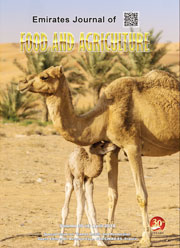EFFECT OF EXOGENOUSLY APPLIED KINETIN AND GLYCINEBETAINE ON METABOLIC AND YIELD ATTRIBUTES OF RICE (ORYZA SATIVA L.) UNDER DROUGHT STRESS
DOI:
https://doi.org/10.9755/ejfa.v27i1.17950Keywords:
Kinetin, Drought, Glycine betain, Proline, Starch, Sugar, Rice, YieldAbstract
Drought is one of the major abiotic stress responsible for yield reduction of crops worldwide. Kinetin (KIN) and glycine betain (GB) have an essential role in regulating cell division during the early phase of grain setting; assimilate flow and osmotic adjustment under drought stress. Effects of exogenously applied kinetin and glycine betain on some metabolic and yield attributes of two rice (Oryza sativa L.) cultivars viz., Basmati-385 and KS-282 were evaluated under water stress. KIN and GB were applied by spraying the plants at flowering stage before drought stress treatment. Both treatments significantly increased proline concentration in leaves and panicles of both the rice cultivars as compared to their control. They also increased soluble sugar in the leaves and panicles under water stress. Starch concentration in leaves and panicles of both the rice cultivars were increased significantly (p<0.05) by KIN and GB spray. However, the magnitude of increase of the starch in panicles was more pronounced in cv. Basmatti-385 than cv. KS-282. Under the applied water stress both KIN and GB spray significantly increased paddy yield in both the rice cultivars. Both KIN and GB spray significantly increased the number of seeds per panicle in both the rice cultivars. The quantitative increase in paddy yield and seed number was greater in cv. Basmatti-385 as compared to cv. KS-282. Exogenous application of KIN at flowering stage could be used as an effective treatment to mimic the adverse effects of water stress in fine rice cultivars.










 .
. 